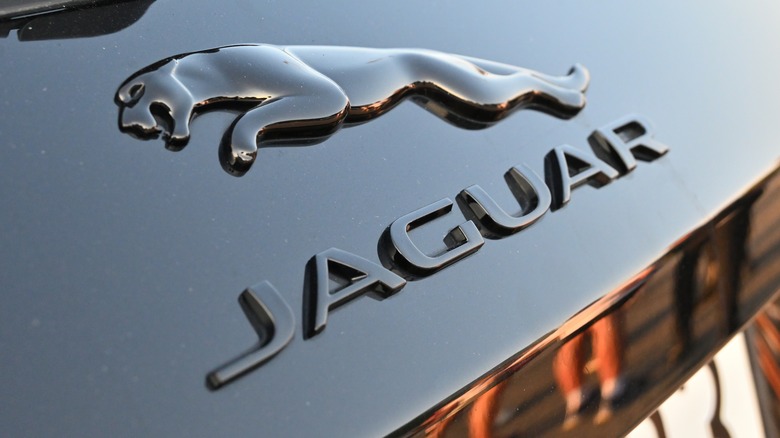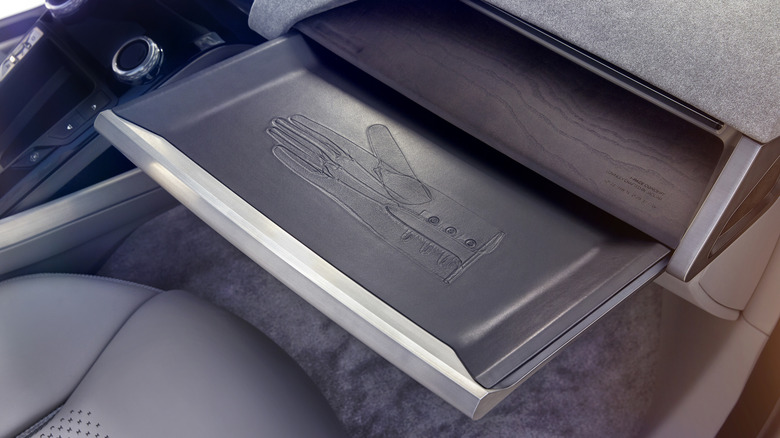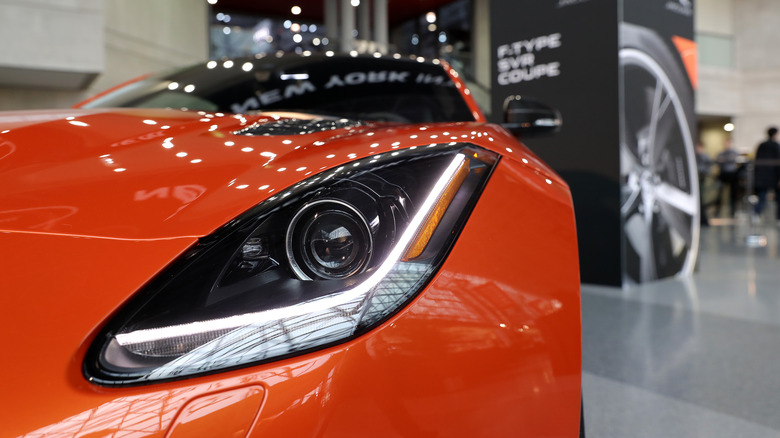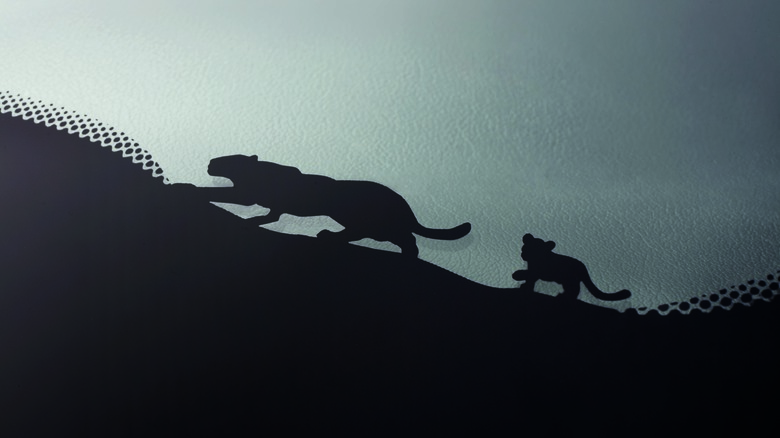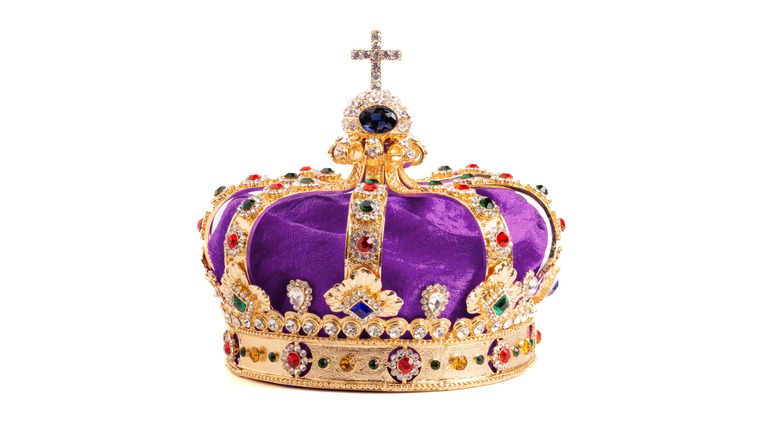The Best Easter Eggs Jaguar Has Put In Its Cars
People love to hunt for Easter eggs, whether it be the kind the giant furry rabbit leaves out in the yard or ones cleverly hidden inside video games, films, or in this case, automobiles. Over the last two decades, car companies have really gotten into surreptitiously popping Easter eggs into their vehicles, little bits and bobbles that have some symbolic meaning that references either the heritage of the car line or the brand itself.
Jeep and Tesla are famously known for hiding these little nuggets. According to Jaguar's Chief Exterior Designer, Matthew Beaven, the regal British car maker has been doing it since at least 2001. He should know since he's been a part of the company for some twenty-three years, with his entire tenure spent working in design.
However, unlike the sometimes not-so-subtle references found in other cars, Jaguar's homages can be so elusive they're almost invisible. Let's take a look at a handful of those nifty hidden gems, some of which take serious sleuthing to uncover.
Conceptually speaking they're still Easter eggs
We said Jaguar has been doling out eggs since 2001, but not always in the conventional sense. That year the company revealed its R-Coupe concept at the Frankfurt Motor Show. While Matthew Beaven designed the exterior, the inside was created by Mark Phillips. Incredibly, the entire concept was designed and built from scratch in less than six months.
The coupe had a center console that ran the entire length of the interior, front to back. Beaven's says tucked inside was a cheeky little addition solely meant for the passenger. What, pray tell, was that addition? A removable whisky flask. An odd choice given today's social movement against drunk driving, although that hot-button topic is viewed much differently in Europe, where the vehicle was built. Plus, Jaguar never had plans to mass-produce this particular car.
Then, in 2016, it unveiled the electric I-PACE concept SUV at the Los Angeles Auto Show, which would later go into full production. Three lines of discreet verbiage are scrawled on the passenger side dashboard of the concept: "I-PACE Concept, Lovingly Crafted by Jaguar, 52 22' 59.8" N 1 29' 37.7" W." Those numbers are the coordinates for Jaguar's headquarters in Coventry, England.
Additionally, the dash included a hidden tray that, when pulled out, showed a drawing of a glove on it – a literal glove box.
F-Type or maybe a T.I.E. Fighter?
When Jaguar dropped the F-Type (first built in 2013 for the 2014 model year), it was the first true roadster to roll out of production in almost 40 years. At least three of its design inspirations could be considered Easter-eggy. First up is the headlights.
According to Wayne Burgess, lead designer of the F-Type, they used vehicles and other elements from films — particularly things created by Industrial Light & Magic. Peering beyond the exterior shield to the projector globe and reflector within, you will see the circular cockpit design of an Imperial T.I.E. Fighter from "Star Wars." It also kinda looks like R2-D2's primary photoreceptor or holographic projector, but a T.I.E. Fighter works too.
At the rear of the F-Type are four exhaust tips. Burgess said they liked to take inspiration from virtually anything that moves (i.e., planes, trains, automobiles). In this case, they fashioned the F-Type's exhaust tips to look like the afterburners of a fighter jet.
One other "egg" is under the hood. This one requires you to know your Jaguar logos and still might take some imagination to make out clearly. Raise the hood and look at the underside. The frame's outline does look vaguely like the famous Jaguar "growler" logo.
The E-PACE was Jaguar's Cub
The E-PACE first hit the streets in 2017 and is Jaguar's smallest SUV. As such, Matthew Beaven said it was unofficially referred to within the design team as "Cub" during its development. Given that it's the tiniest of the lot, it made sense for them to drop an egg or two (or three) into the vehicle to pay tribute.
Looking closely at the black outline surrounding the windshield, you'll see a small cub frolicking behind a full-grown (perhaps mama) jaguar. Yes, the earworm song that is "Hakuna Matata" probably immediately sprang into your brain. If you are fortunate enough to have a First Edition model, this very same image is splashed on the ground by the welcome lights (aka puddle lamps) when you open the doors.
But that's not the only hidden nod to the jag. At first glance, both the seat labels and the stowage mats have a sort of ambiguous decorative design on them. Upon further inspection, however, you'll see that the pattern is actually that of the jaguar's distinctive fur markings.
Purple Rain, Purple Rain
The connection between the loud, flamboyant artist formerly known as Prince and the reserved British car maker might be somewhat of a head-scratcher until you realize both liked the color purple, which is the one most commonly associated with royalty.
In 2010, Jaguar created the XJ75 Platinum Design Concept and showed it off at the 2010 Pebble Beach Concours d'Elegance to lots of fanfare. Bespoke from top to bottom, this one-of-a-kind vehicle contained what can best be described as the single most colorful Easter egg to ever appear in a Jaguar, one that was more or less hidden in plain sight.
But once someone opened up the center console or the glove box, they were met with a dazzling display of purple brilliance. Unexpectedly, each was lined with a purple suede-like fabric called Mauveine, and it most definitely stood out from the rest of the vehicle. Much the same way Prince did among his peers during his purple reign.
When Jaguar made the Supersport version of the XJ available to the public a few years later, one of the features it brought over from the XJ75 Platinum Concept was that same purple Mauvine lining, this time placing it not just in the storage compartment, but under the center armrest as well. It also lined the center console and the champagne bottle cooler inside the XJ Ultimate.
